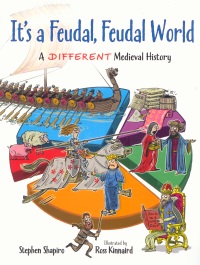| ________________
CM . . .
. Volume XX Number 6. . . .October 11, 2013 
 |
It’s a Feudal, Feudal World: A Different Medieval History.
Stephen Shapiro. Illustrated by Ross Kinnaird.
Toronto, ON: Annick Press, 2013.
44 pp., trade pbk. & hc., $14.95 (pbk.), $24.95 (hc.).
ISBN 978-1-55451-552-3 (pbk.), ISBN 978-1-55451-553-0 (hc.).
Subject Headings:
Civilization, Medieval-Juvenile literature.
Middle ages-Juvenile literature.
Grades 3-6 / Ages 8-11.
Review by Ian Stewart.
**** /4
|
| |
|

excerpt:
What were the Middle Ages?
The middle ages were the thousand years of history in Europe between 500 CE and 1500 CE. This was an age of kings and queens, knights and castles, peasants and plows…but this was also an age of caliphs and khans, longships and libraries, Silk Roads and synagogues. This is a different history of the Middle Ages.
A different history?
Yes. A different history told in a different way—through infographics.
What’s an infographic?
An infographic is an image that explains something involving numbers or patterns, like a chart or a diagram.
This really is a “different Medieval history!” Stephen Shapiro eschews the traditional narrative format in his history. This allows him to undertake a conceptualized examination of life’s diversity and the complexity of social interaction during the 1000 years that make up the Medieval period.
Often students are only given the opportunity to explore the middle ages period through the lens of Christian, northern European feudalism, and so they develop the idea that life was politically and socially static. After reading Shapiro’s It’s a Feudal, Feudal World, students will develop a more sophisticated understanding of the period.
Even though it was the time of kings, castles, knights and ladies, and a lot a peasants, a thousand years is a long time. The Medieval society Shapiro offers readers contains more socially and culturally diverse elements, cosmopolitan tinges, as well as an agrarian base, intellectual and religious diversification, along with Vikings and merchants crisscrossing the known world more than what has been traditionally taught.
Consequently, Shapiro’s text will be a wonderful supplement to whatever textbook is being used in the classroom. His imaginative bar graphs, line graphs and pie graphs, charts, maps, assorted diagrams and inventive cartoons inventively illustrate, as well as compare and contrast, how medieval people lived.
The section “On the Road” gives readers one interesting example of an infograph. Shapiro tells readers that all kinds of people were travelling during the Middle Ages: messengers carried urgent letters, merchants transported their wares, clerics preached their religion and pilgrims went from holy place to holy place in the search for salvation. How far could they travel in a day? Shapiro’s bar graph shows that a pilgrim could walk 32 km in a day, a merchant on a camel could go 40 km, a diplomat on a horse could make 56 km, a Viking raiding ship might row 152 km and a trading ship could sail 192 km.
In the section “Growing up”, readers learn from Shapiro’s pie graph that the greatest cause of infant mortality was not disease but fires in the home. Readers also learn that everyone started to work at age 12 but that nobles married at 15-16 years and artisans and peasants at 25-27.
Readers also learn about world population distribution, the three monotheistic religions, about merchants travelling the Silk Road and how much goods costs, the rise and fall of cities, who died during the black death (60% of the general population but only 41% of the nobles and a high percentage of scribes who wrote out the will for the sick), the books in royal libraries, the crusades and how to conquer a castle.
Shapiro has written a creative and useful book that will be an added treasure to any school library or classroom.
Highly Recommended.
Ian Stewart teaches at Cecil Rhodes School in Winnipeg, MB.

To comment
on this title or this review, send mail to cm@umanitoba.ca.
Copyright © the Manitoba Library Association. Reproduction for personal
use is permitted only if this copyright notice is maintained. Any
other reproduction is prohibited without permission.
NEXT REVIEW |
TABLE OF CONTENTS FOR THIS ISSUE
- October 11, 2013.
AUTHORS |
TITLES |
MEDIA REVIEWS |
PROFILES |
BACK ISSUES |
SEARCH |
CMARCHIVE |
HOME |
